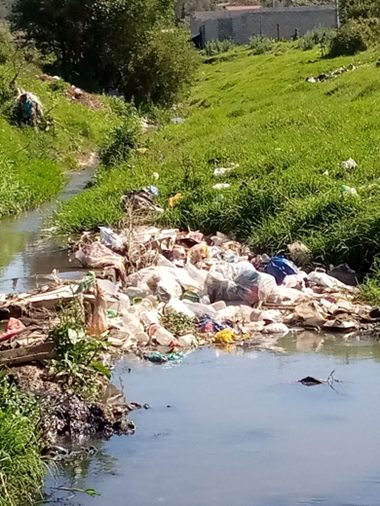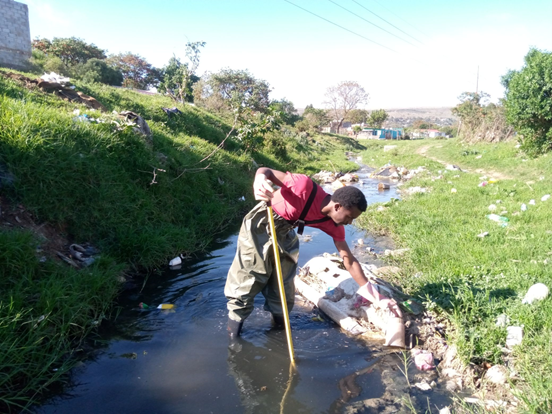5
JANUARY, 2024
Skyscrapers and floating mansions in the rivers: macroplastic habitats
By: Andrew Abagai ALI
PhD student (Water Resource Science), Institute for Water Research, Rhodes University; Volunteer, River Rescue Makhanda.

Rivers don’t follow strict borders because they cross many boundaries. They are often shared by multiple neighbours, across different countries, provinces, or communities. They flow through and connect different areas. What happens in one part of the river can affect the entire river. Keeping a river in its natural state requires cooperation and understanding in the places it touches.
River systems are delicate communities, where a rich web of life thrives – the rivers are home to a variety of creatures: tiny bugs, fish, to larger animals like otters and birds. The water, plants, and riverbed create a balanced environment where each organism plays an important role.
BUT … this natural balance is under threat! Improper waste disposal, and the belief that rivers are meant to transport garbage are killing our rivers. About 70% of this garbage is plastics, which are durable and persistent in the environment. This plastic can disrupt the harmony of the river community; it harms aquatic life in multiple ways: larger animals mistaken smaller plastic for food; larger pieces of plastic trap smaller animals, making it difficult to move and feed.
I’m interested in understanding what will happen when plastics take over natural riverine habitats, how they interact with aquatic organisms, and the long-term effects on humans and our environment.
Why should we care about macroplastic habitats in rivers?
Here is something for you to think about!
Imagine the river as a giant neighbourhood, and within it, there’s a particular area you can think of as the “macroplastic habitat”. This special zone is like a fancy skyscraper, or even a free-floating yacht made of large plastic items, such as bottles and bags, with no firm foundation or proper ventilation. Just like a new neighbour moving into a neighbourhood, these macroplastics bring both positive and negative changes to the aquatic community. On the positive side, the plastic can provide temporary shelter for some aquatic creatures, acting like a cozy home or a cool hangout spot. These new places may influence the natural flow of life, affecting everything from tiny bugs to big organisms, all of which have essential roles in the rivers. However, because there is no firm foundation and proper ventilation, macroplastic habitats also come with downsides: they can harm the local residents, causing confusion and sometimes even evicting the original inhabitants of the area.

Let’s zoom out and look at the bigger picture – the biosphere. This is like the entire town whereas our aquatic neighbourhood is just a tiny part. The plastic junk in the aquatic ecosystem is like a messy, poorly maintained district within the city. It might not seem like a big deal at first, but it can have far-reaching consequences. If we don’t address the macroplastic habitat in our aquatic neighbourhood, it’s like letting a neglected part of our town become a dumping ground, and that affects the well-being of the entire biosphere. When a flood or wind comes, the inhabitants of the biosphere are vulnerable – it’s like a natural disaster because there are no natural buffers on a macroplastic habitat. So, just as we would not want our city to be known as a polluted and messy neighbourhood, it’s crucial to clean up and take care of the garbage in the aquatic ecosystem for the health of our entire environment.
How can we prevent this unsustainable riverine macroplastic habitat from destroying the natural environment?
The world is facing unmatched climate challenges, but rivers can serve as natural buffers to climate change through several key mechanisms. For example, rivers regulate local temperature, they prevent flooding, and they support various organisms. Recognising and preserving the natural functions of rivers is essential to make the most of their role as buffers against climate change. Human behaviour – what WE do – particularly the widespread use of disposable single-use plastics, significantly contributes to plastic pollution, which in turn, compromises these riverine functions. All stakeholders – everyone – must be on board to tackle plastic pollution in the environment, from source to endpoint.
Remember the biblical parable of a wise one who built his house upon the rock, a solid foundation; the rain fell, the flood came, and the wind blew and beat upon that house, but the house did not fall. In the same way, aquatic systems and organisms depend solely on human activities which may sometimes be the building blocks of their environment. Thus, humanity is faced with a choice: continue on an unsustainable trajectory or stop, think, listen and learn from nature.
Nature offers multiple solutions to the many problems facing humanity today, and there is still time to apply them. But time is running out, and the need for action is now.
How can I contribute to this change?
To reduce plastic pollution in rivers and its interaction with riverine habitats and organism, you can adopt a series of mindful practices, today.
- Minimize your use of single-use plastics, opting for reusable alternatives, and properly disposing of waste to prevent it from reaching rivers
- Actively participate in community clean-up activities along riverbanks and tell your friends about the environmental impact of plastic pollution
- Support plastic-free initiatives and businesses prioritizing sustainability
- Volunteer with environmental organizations dedicated to river conservation
- Choose to use sustainable products
- Practice responsible outdoor recreation
- Advocate for policy changes that promote reduced plastic use and improved waste management.
By incorporating these efforts into your lifestyle and encouraging others to do the same, you can play a vital role in safeguarding the health of rivers and their ecosystems – and in creating a safer environment for everyone.

